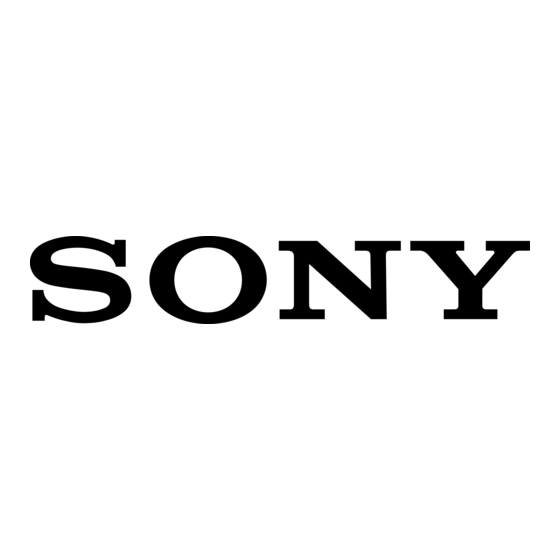Sony PICTURE STATION DPP-FP90 Brochure & Specs - Page 26
Parcourez en ligne ou téléchargez le pdf Brochure & Specs pour {nom_de_la_catégorie} Sony PICTURE STATION DPP-FP90. Sony PICTURE STATION DPP-FP90 31 pages. Digital photo printer
Également pour Sony PICTURE STATION DPP-FP90 : Garantie limitée (1 pages), Lisez d'abord ceci (2 pages), Manuel d'entretien (27 pages)

Sharing your pictures
Thanks to the BIONZ
™
processor, Sony's Auto Touch-Up function analyzes, detects and corrects image faults at the press of a single button. (Sample photos for illustration purposes.)
PC-free printing
Optimized printing with
No need to connect a PC, no need to
boot up.
Print adjustments based on photo
exposure mode.
While just booting up the PC can be time
consuming, PC-free printing is quick. Sony
In digital photography, each picture is a file
digital photo printers are always ready to go
that can include "Exif tag" information about
right away. You can connect the camera via
the camera, date, time, shutter speed, lens,
USB. Or you can slide the Memory Stick
®
shooting mode and more. When the
media out of a Cyber-shot
®
camera and
DPP-FP70 and DPP-FP90 see image files
into the DPP-FP70 or FP90 printer.
from current Sony cameras, the printers
actually read the Exif tags and set print
parameters according to the original exposure
Auto Touch-Up
™
function
mode. So a picture shot in Twilight Portrait
mode will be printed differently from one
Don't just print your pictures, improve them
shot in Sports mode.
with the power of Sony's BIONZ
™
processor.
Built-in LCD monitor
The DPP-FP70 and DPP-FP90 both
incorporate the same BIONZ
™
image
processor that made its debut in Sony's
For in-printer editing and creative printing
a100 Digital SLR. The processor has the
options.
uncanny ability to analyze picture data,
spot photographic issues and correct
The DPP-FP70 features a built in 2.5-inch
them automatically. At the press of a
LCD monitor (viewable area measured
single button, Sony's Auto Touch-Up
™
diagonally), while the DPP-FP90 features
function actually improves the picture,
an even bigger 3.6-inch monitor (viewable
correcting red-eye, exposure and focus.
area measured diagonally).
48
Media card flexibility
Sony cameras
Accepts a variety of media card types.
The DPP-FP70 and DPP-FP90 both accept
Memory Stick PRO
™
media, Memory Stick
PRO Duo
™
media, Secure Digital
MiniSD
™
, MultiMediaCard
™
or MicroDrive
™
cards.
Dye sublimation with
16.7 million colors
Thousands of times more color possibilities
for each individual dot, when compared
to inkjet printers.
A 4-color inkjet printer can reproduce any
individual dot in 2
4
or 16 distinct colors.
A 7-color inkjet printer can reproduce 2
(128) distinct colors per dot. In dramatic
contrast, Sony DPP-FP70 and DPP-FP90
dye sublimation printers can print three
dye colors – cyan, magenta and yellow –
While inkjet printers might be able to muster as few as
16 distinct colors per dot, Sony dye sublimation printers
can reproduce 16,777,216 colors per dot. That's a much
bigger box of crayons!
in 256 shades of each! Do the math and
256 x 256 x 256 equals 16,777,216
distinct colors for each pixel. Inkjet printers
just can't come close.
Because inkjet printers can't match this range
of colors, they need to approximate the correct
color by printing a cluster or neighborhood
of much smaller dots. Inkjet printer dots do
not create a continuous tone. And the smaller
dots create challenges for the transfer
head and paper media. Because the Sony
DPP-FP70 and DPP-FP90 dye sublimation
printers generate a true, continuous tone,
they do not incur these issues.
To equal the color resolution of a Sony dye
sublimation printer, inkjet printers require
far, far smaller dots. So comparing dye
sublimation dpi to inkjet dpi is not like
comparing apples to oranges. It's more
like comparing apples to thumbtacks.
™
, SDHC
™
,
, CompactFlash
™
SILVER HALIDE
PHOTO
Conventional photo printing (left) can't match the range
of colors of Sony dye sublimation (right). (Sample photos
for illustration purposes.)
Color gamut
A wider range of colors, particularly
reds and yellows, than conventional
photochemical prints.
7
If you think of silver halide chemical
processing as the gold standard in photo
prints, you may need to reconsider. The
Sony DPP-FP70 and DPP-FP90 dye
sublimation printers actually have a
superior range or "gamut" of colors,
especially in the reds and yellows. This
means you'll see vivid, natural colors that
conventional photo prints are quite simply
unable to duplicate!
INKJET PRINTER
DYE SUBLIMATION PRINTER
It takes a neighborhood of many inkjet printer "dots" (top) to equal a single dot from a Sony dye sublimation printer!
Clearly, not all dots are created equal.
DYE SUBLIMATION
YELLOW
PRINTING
CIE LAB COLOR SPACE
BRILLIANT COLOR
+b*
100
80
RED
60
40
GREEN
20
-a* -100 -80 -60
-40 -20
20
40
60
80 100 +a*
0
-20
MAGENTA
-40
-60
CYAN
-80
BLUE
-100
-b*
SONY DYE SUBLIMATION PRINTER
SILVER HALIDE PHOTO
INKJET PRINTER
The CIE l*a*b* color chart demonstrates the superiority
of Sony dye sublimation printing.
The durability of the Sony
SuperCoat2
™
treatment
Stands up to fingerprints, liquid spills
and the ravages of time.
Our DPP-FP70 and DPP-FP90 dye
sublimation printers work by drawing
1 color ink dot =
"1 dot"
300 x 300 pixels
1"
1 pixel of
image data =
"1 dot"
the paper through the printer multiple
times (once for each of three primary
colors). Sony used this as an opportunity
for a fourth pass – fusing a protective
laminate that we call the SuperCoat2
™
finish. This incredibly durable coating
protects the surface of each print from
fingerprints, splashes of liquid and fading.
So your prints remain fresh and beautiful
year after year.
The Sony SuperCoat2 treatment protects your precious
memories from stains, spills and the ravages of time.
(Sample photo for illustration purposes.)
49
